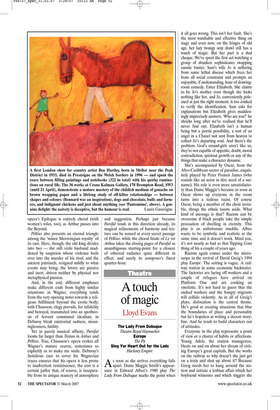Chez Chausson
Robin Holloway
Every eager collector of books and scores has their special searcher, primed to keep an eye open for long outof-print rarities at reasonable prices. Mine, like Jesus’ blood, ‘never failed me yet’. Her latest triumph is to have procured a copy of Ernest Chausson’s opera Le roi Arthus, posthumously produced in 1903, four years after his death at 44; never yet staged in this country, though there was a memorable concert performance at the Edinburgh Festival a few years ago. I’d been on the lookout for the music for ages, and its eventual arrival brought down from the shelf the fraying tape of a previous recording dating back to 1987, to listen again to a work of rare nobility.
Chausson is in danger of being remembered as a one-work composer: and even that one work, the lovely poème for violin and orchestra, isn’t played nearly so frequently as it used to be and always deserves. Pupil of Massenet, follower of Franck, elder (by nine years) contemporary and close friend of Debussy’s younger days, he was more serious (Earnest) than his friend, a slow developer prone to doubts and scruples, German-facing, more bound to tradition. And he’s not in the same league: there’s too much conscientious homework and dutiful piety. The bolder, leaner spirit with his utterly original way of hearing was able to embrace a liberating range of exotic influences, thus severing himself from his immediate origins even while retaining their loving tincture, transformed into something strange and new.
Chez Chausson, a handful of rather overwrought chamber works and a fine symphony just about survive at the edge of the repertory. More secure, some treasurable songs with piano and an extended cycle with orchestra, Poème de l’amour et de la mer, whose close, Le temps des lilas, epitomises a particular mauve-scented French nostalgia whose most extended experience comes in opening volumes of Proust.
Any young composer in fin-de-siècle Paris was fated to be in thrall to Wagner. Chausson made the obligatory pilgrimages to Munich and Bayreuth to soak himself in Tristan and Parsifal well before they crossed the Rhine. As with Debussy (who joined the sacred trail rather later) the struggle to compose their respective operas is the struggle to slough off the overwhelming, irresistible seduction of these omnipotent prototypes. Their correspondence of the late 1880s–early 90s vividly recounts the conscious need to escape the ‘poison’ of ‘Old Klingsor, alias R. Wagner’.
Le roi Arthus and Debussy’s Pelléas et Mélisande are both variants upon Wagner’s Tristan in story. Chausson’s plot (his own libretto) is more literally related. Its source is also Celtic, its core also an adulterous triangle wherein the older husband is deceived by his beautiful young queen and his most devoted knight in a context of chivalry dishonoured. For Marke/Isolde/ Tristan, substitute Arthur/Guinevere/ Lancelot. Betrayal is brought about by the lovers’ envious rival (Melot/Mordred) and, more subtly, by what lies within, whether death-devoted affinity or something rotten with carnal desire. Guinevere has no maid to correspond to Isolde’s crafty confidante Brangäne, who sets the entire machinery in motion; but Lancelot’s faithful Lyonel exactly matches Tristan’s Kurwenal. The only unmirrored principal is Chausson’s Merlin, summoned up by Arthur in his distress to allay suspicions which his reluctance only strengthens, before he then proceeds to foretell the demise of the Round Table and the dissolution of Arthur’s kingdom. And while the chorus in Tristan is confined to hostile, mocking, then ironically jubilant sailors in Act I only, its role in Chausson is important throughout, and the opera’s Epilogue is entirely choral (with women’s wiles, too), as Arthur passes into the Beyond.
Pelléas also presents an eternal triangle among the ‘minor Merovingian royalty’ of its cast. Here, though, the old king divides into two — the still virile husband maddened by suspicion whose violence boils over into the murder of his rival, and the ancient patriarch, resigned mildly to what events may bring; the lovers are passive and inert, driven neither by physical nor metaphysical passion.
And, in the end, different emphases make different ends from highly similar situations: in Wagner, everything tends from the very opening notes towards a religious fulfilment beyond the erotic body; with Chausson, elegy prevails, for infidelity and betrayal, transmuted into an apotheosis of fervent communal idealism; in Debussy bleak existential sadness, meaninglessness, futility.
Yet in purely musical affinity, Parsifal looms far larger than Tristan in Arthus and Pelléas. True, Chausson’s opera evokes all Wagner’s mature oeuvre, sometimes so explicitly as to make me smile. Debussy’s fastidious care to cover his Wagnerian traces ensures that his opera is less prone to inadvertent reminiscence; the cost is a certain pallor that, of course, is inseparable from its unique mastery of atmosphere and suggestion. Perhaps just because Parsifal tends in this direction already, its magical refinements of harmony and texture can be sensed at every secret passage of Pelléas: while the choral finale of Le roi Arthus takes the closing pages of Parsifal as unambiguous starting-point for a closure of ethereal radiance quite different in effect, and surely its composer’s finest quarter-hour.











































































 Previous page
Previous page